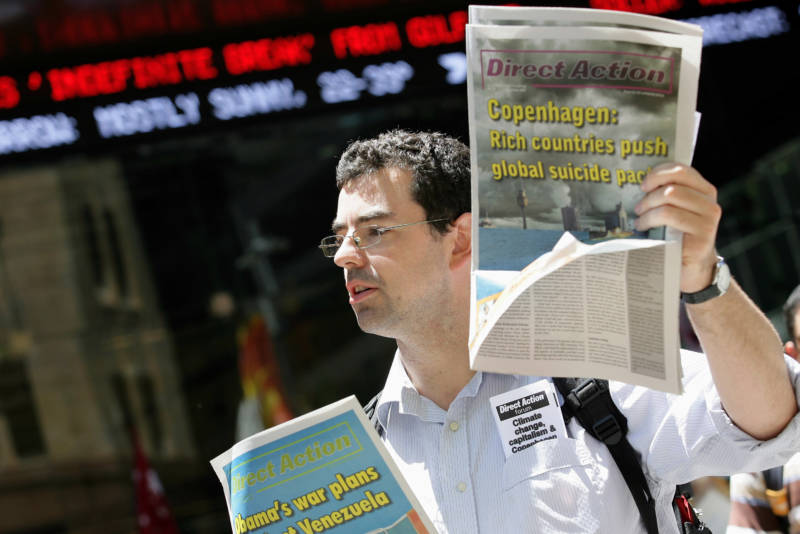The public is paying a lot more attention to climate change news stories. That’s the thrust of Andrew McCormick’s piece in the Columbia Journalism Review this week, challenging the conventional wisdom that people’s interest in the topic is low. Confronted with a report about climate change, this view holds, most news consumers will change the channel, turn the radio dial, click off the website.
You Are Now Much More Likely to Read This Climate Change Story

According to the CJR report, only 22 of the 50 biggest newspapers in the U.S. covered the release of an October 2018 report from the Intergovernmental Panel on Climate Change that said humanity had just 12 years to reduce emissions or face an even worse level of catastrophic impacts than it already does.
MSNBC host Chris Hayes captured the media’s reluctance to delve into the climate story with a July 2018 tweet.
“Almost without exception, every time we’ve covered it’s been a palpable ratings killer,” Hayes wrote. “So the incentives are not great.”
But that appears to be changing, McCormick reports. He writes:
“A review of industry-wide data and accounts from numerous top-line publications suggest that audience interest in climate coverage is, in fact, on the rise, and that dedicating resources to the story might suit companies’ bottom lines.”
McCormick reached that conclusion after CJR obtained January 2017 to June 2019 data from about 1,300 media outlets, mainly from North America and Europe. He enlisted the help of data scientist Su Hang and her team at Chartbeat, a web analytics company, to crunch the numbers.
Looking at the first quarter of each year, Hang found the number of total minutes people spent reading climate change stories, which Chartbeat says represents “attentive traffic,” almost doubled from 2017 to 2019. At the same time, Hang noted, the number of articles published about climate change were up just 27%, an increase that wouldn’t alone account for the big jump in engaged minutes. Hang’s team defined a climate change story as any piece that included a discussion of the issue.
“You would expect people that are randomly bumping around the internet to be reading 20 or 30 percent more, but what we are seeing is that they are doubling their attention,” Hang said.
The increase in reader attention was also fairly steady over time, according to Josh Schwartz, head of the data science team at Chartbeat. That means the rise in engagement wasn’t driven by single blockbuster news events.
“There are certainly huge news events like the U.S. withdrawing from the Paris climate accord, but for the most part, this is a week-over-week increase. It is not individual stories blowing it out and changing the curve,” he said.
Why?
What is unclear is what’s driving the increased interest. In an email, CJR’s McCormick said he thinks that some outlets are “finding ways to crack the code” on covering the climate.
“Especially those that are finding ways to localize the issue,” he said. “That is, explaining the local environmental impacts of climate change or explaining how climate change is playing a role in extreme weather events in whatever region those publications serve.”
Whatever the reason, McCormick says it’s clear from his interviews with experts and editors at media outlets that people are hungrier for climate change reporting.
“The unfortunate irony here is that climate change concern is on the rise because extreme weather events are happening with increased frequency and duration,” he said. “That is, audiences are seeing it and they’re now finally believing that it will affect them.”
Climate Anxiety
How that concern translates into people’s engagement with media is unclear. But the most recent Public Policy Institute of California annual poll on the environment suggests that the public’s climate anxiety is driven by actual disasters linked to global warming. This year, for instance, 71% of Californians said they were “very concerned” about wildfires becoming more severe due to climate change, a record high for the poll. The survey was conducted about eight months after last year’s Camp Fire, the deadliest U.S. wildfire in 100 years, which was followed by months of media coverage on the state’s perilous wildfire conditions.
But in the same poll, just 30% of Californians said the water supply is a “big problem,” down from nearly 50% in 2018. That result came after the state’s drought officially ended because of a particularly strong water year.
Similarly, only 42% expressed a strong concern about higher sea levels, even though one U.S. Geological Survey study showed that 600,000 coastal residents and $150 billion worth of property and infrastructure are now threatened with inundation from rising seas.
KQED Science’s own metrics seem to bear out the theory that the increasingly tangible effects of global warming are having an effect on the audience’s interest in the topic.
“We’ve done several climate-related series,” said KQED Science Digital Editor Jon Brooks, “but our recent group of stories on ways to decrease the threat from worsening wildfires attracted by far the biggest audience.”
Another reason people might be more focused on the climate is that as temperatures continue to rise and storms become more frequent and severe, the coverage increasingly reflects a sense of urgency. The Guardian, for instance, now refers to global warming as a “climate crisis.”
McCormick thinks the media stumbled in the past by assuming that climate change is largely a science story. He said climate change angles can and should be included in a broad array of stories, just like economics or politics.
“Climate change is going to permeate most aspects of human life,” he said. “In some places, it already is. Many folks I spoke with emphasized that climate change is a dramatic human story — a food story, a housing story, a national security story and more.”